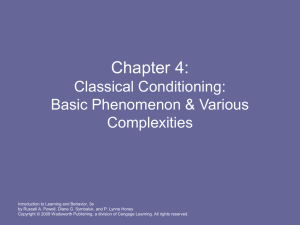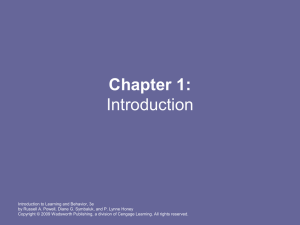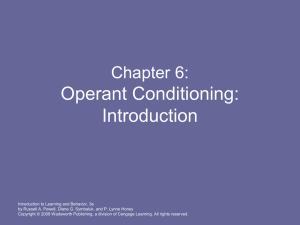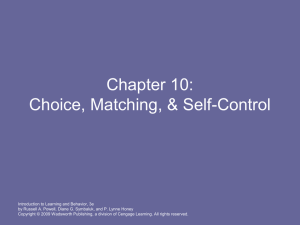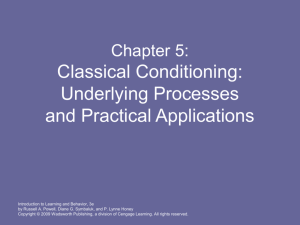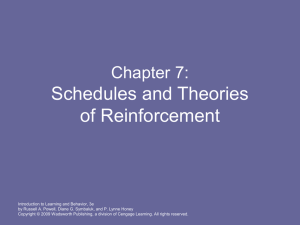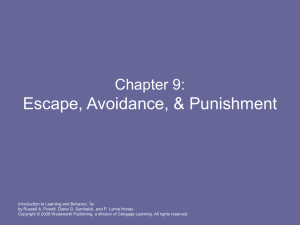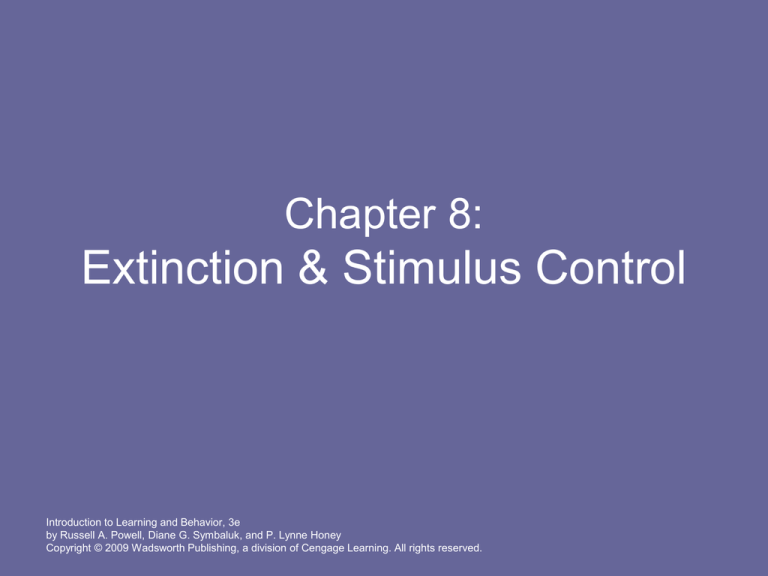
Chapter 8:
Extinction & Stimulus Control
Introduction to Learning and Behavior, 3e
by Russell A. Powell, Diane G. Symbaluk, and P. Lynne Honey
Copyright © 2009 Wadsworth Publishing, a division of Cengage Learning. All rights reserved.
Extinction
• the nonreinforcement of a previously reinforced
response, the result of which is a decrease in
the strength of that response.
• It refers to both a procedure and a process.
• The procedure of extinction is the
nonnreinforcement of a previously reinforced
response.
• The process of extinction is the resultant
decrease in response strength.
Introduction to Learning and Behavior, 3e
by Russell A. Powell, Diane G. Symbaluk, and P. Lynne Honey
Copyright © 2009 Wadsworth Publishing, a division of Cengage Learning. All rights reserved.
Example
• a rat has learned to press a lever for food:
Lever press Food
R
SR
• If lever pressing is no longer followed by food:
Lever press No food
R
—
• then the frequency of lever pressing will decline.
Introduction to Learning and Behavior, 3e
by Russell A. Powell, Diane G. Symbaluk, and P. Lynne Honey
Copyright © 2009 Wadsworth Publishing, a division of Cengage Learning. All rights reserved.
Example, continued
• In this example,
– The act of withholding food delivery following a lever
press is the procedure of extinction.
– The resultant decline in responding is the process of
extinction.
• If lever pressing ceases entirely, the response is
said to have been extinguished.
• If it has not yet ceased entirely, then the
response has been only partially extinguished.
Introduction to Learning and Behavior, 3e
by Russell A. Powell, Diane G. Symbaluk, and P. Lynne Honey
Copyright © 2009 Wadsworth Publishing, a division of Cengage Learning. All rights reserved.
Identify the reinforcer
• When applying an extinction procedure, be
sure that the consequence being withheld
is in fact the reinforcer that is maintaining
the behavior.
• Determining the effective reinforcer that is
maintaining a behavior is a critical first
step in extinguishing a behavior.
• Example:
– Whining child
Introduction to Learning and Behavior, 3e
by Russell A. Powell, Diane G. Symbaluk, and P. Lynne Honey
Copyright © 2009 Wadsworth Publishing, a division of Cengage Learning. All rights reserved.
Side Effects of Extinction
• When an extinction procedure is
implemented, it is often accompanied by
certain side effects, including:
– Extinction Burst.
– Increase in Variability.
– Emotional Behavior.
– Aggression.
– Resurgence.
– Depression.
Introduction to Learning and Behavior, 3e
by Russell A. Powell, Diane G. Symbaluk, and P. Lynne Honey
Copyright © 2009 Wadsworth Publishing, a division of Cengage Learning. All rights reserved.
Extinction Burst
• a temporary increase in the frequency and
intensity of responding when extinction is
first implemented.
• Examples:
– Rat will press the lever both more rapidly and
more forcefully.
– You press the button on the candy machine
several times in a row, often with increasing
amounts of force.
Introduction to Learning and Behavior, 3e
by Russell A. Powell, Diane G. Symbaluk, and P. Lynne Honey
Copyright © 2009 Wadsworth Publishing, a division of Cengage Learning. All rights reserved.
Increase in Variability
• Examples:
– If the rat typically pressed the lever with its
right paw, it might now try pressing it with
its left paw.
– If the rat usually pressed the lever in the
center, it might now press it more to one
side or the other.
– You hold down the button on the candy
machine before releasing it or try pressing
other buttons to get the candy out.
Introduction to Learning and Behavior, 3e
by Russell A. Powell, Diane G. Symbaluk, and P. Lynne Honey
Copyright © 2009 Wadsworth Publishing, a division of Cengage Learning. All rights reserved.
Emotional Behavior
• We typically refer to these behaviors as
frustration.
• Examples:
– Agitated behavior of a pigeon
– Angry behavior in response to the candy
machine
Introduction to Learning and Behavior, 3e
by Russell A. Powell, Diane G. Symbaluk, and P. Lynne Honey
Copyright © 2009 Wadsworth Publishing, a division of Cengage Learning. All rights reserved.
Aggression
• an emotional response to extinction.
• Examples:
– A pigeon whose key pecking is placed on
extinction will reliably attack another pigeon.
– Uncooperative vending machines are
sometimes attacked.
Introduction to Learning and Behavior, 3e
by Russell A. Powell, Diane G. Symbaluk, and P. Lynne Honey
Copyright © 2009 Wadsworth Publishing, a division of Cengage Learning. All rights reserved.
Resurgence
• the reappearance during extinction of
other behaviors that had once been
effective in obtaining reinforcement.
• Example:
– A husband faced with a wife who largely
ignores him might begin spending increasing
amounts of time at his parents’ house.
Introduction to Learning and Behavior, 3e
by Russell A. Powell, Diane G. Symbaluk, and P. Lynne Honey
Copyright © 2009 Wadsworth Publishing, a division of Cengage Learning. All rights reserved.
Depression
• Low activity is a common symptom of
depression.
• Example:
– If someone dies, the people for whom that
individual was a major source of
reinforcement will likely become depressed
for a period of time.
Introduction to Learning and Behavior, 3e
by Russell A. Powell, Diane G. Symbaluk, and P. Lynne Honey
Copyright © 2009 Wadsworth Publishing, a division of Cengage Learning. All rights reserved.
Problems with Side Effects
• Side effects of extinction impede
successful implementation of extinction.
• Side effects can be inadvertently
strengthened if one suddenly gives in and
provides the subject with the sought-after
reinforcer.
• Example:
– Whining child
Introduction to Learning and Behavior, 3e
by Russell A. Powell, Diane G. Symbaluk, and P. Lynne Honey
Copyright © 2009 Wadsworth Publishing, a division of Cengage Learning. All rights reserved.
Resistance to Extinction
• the extent to which responding persists after an
extinction procedure has been implemented.
• A response that is very persistent is said to have
high resistance to extinction.
• A response that disappears quickly is said to
have low resistance to extinction.
• Example:
– Dog begging for food
Introduction to Learning and Behavior, 3e
by Russell A. Powell, Diane G. Symbaluk, and P. Lynne Honey
Copyright © 2009 Wadsworth Publishing, a division of Cengage Learning. All rights reserved.
Resistance to Extinction, continued
• Resistance to extinction can be affected
by a number of factors, including:
– Schedule of Reinforcement.
– History of Reinforcement.
– Magnitude of the Reinforcer.
– Degree of Deprivation.
– Previous Experience With Extinction.
– Distinctive Signal for Extinction.
Introduction to Learning and Behavior, 3e
by Russell A. Powell, Diane G. Symbaluk, and P. Lynne Honey
Copyright © 2009 Wadsworth Publishing, a division of Cengage Learning. All rights reserved.
Schedule of Reinforcement
• The partial reinforcement effect means that
behavior that has been maintained on an
intermittent schedule will extinguish more slowly
than behavior that has been maintained on a
continuous schedule.
• Resistance to extinction is particularly strong
when behavior has been maintained on a
variable ratio schedule.
• The less frequent the reinforcer, the longer it
takes the animal to “discover” that reinforcement
is no longer available.
Introduction to Learning and Behavior, 3e
by Russell A. Powell, Diane G. Symbaluk, and P. Lynne Honey
Copyright © 2009 Wadsworth Publishing, a division of Cengage Learning. All rights reserved.
Example
• A behavior reinforced on a FR 10 schedule will
take longer to extinguish than a behavior
reinforced on a CRF (FR 1) schedule.
• A behavior reinforced on a FR 100 schedule will
take longer to extinguish than a behavior
reinforced on an FR 10 schedule.
• A VR 20 schedule will produce greater
resistance to extinction than an FR 20 schedule.
Introduction to Learning and Behavior, 3e
by Russell A. Powell, Diane G. Symbaluk, and P. Lynne Honey
Copyright © 2009 Wadsworth Publishing, a division of Cengage Learning. All rights reserved.
Unwanted Behavior
• The partial reinforcement effect helps account
for unwanted behaviors that are difficult to
eliminate.
• Since behavior that has been continuously
reinforced is less resistant to extinction, it might
help to first spend several days reinforcing each
instance of the unwanted behavior.
• Example:
– Dog begging for food.
Introduction to Learning and Behavior, 3e
by Russell A. Powell, Diane G. Symbaluk, and P. Lynne Honey
Copyright © 2009 Wadsworth Publishing, a division of Cengage Learning. All rights reserved.
History of Reinforcement
• The more reinforcers an individual has received
for a behavior, the greater the resistance to
extinction.
• It is much easier to extinguish an unwanted
behavior when it first becomes evident.
• Examples:
– Rat reinforced 10 times vs. 100 times
– Child who has recently been reinforced for whining
vs. child who has been reinforced for a long time
Introduction to Learning and Behavior, 3e
by Russell A. Powell, Diane G. Symbaluk, and P. Lynne Honey
Copyright © 2009 Wadsworth Publishing, a division of Cengage Learning. All rights reserved.
Magnitude of the Reinforcer
• Large-magnitude reinforcers sometimes result in
greater resistance to extinction than smallmagnitude reinforcers.
• It may take longer to extinguish a behavior which
has resulted in a highly preferred reinforcer than
a less-preferred reinforcer.
• Examples:
– Large amounts of food vs. small amounts
– Preferred food vs. less preferred food
Introduction to Learning and Behavior, 3e
by Russell A. Powell, Diane G. Symbaluk, and P. Lynne Honey
Copyright © 2009 Wadsworth Publishing, a division of Cengage Learning. All rights reserved.
Degree of Deprivation
• The greater the level of deprivation, the
greater the resistance to extinction.
• Example:
– A rat that is only slightly hungry will cease
lever pressing more quickly than a rat that is
very hungry.
Introduction to Learning and Behavior, 3e
by Russell A. Powell, Diane G. Symbaluk, and P. Lynne Honey
Copyright © 2009 Wadsworth Publishing, a division of Cengage Learning. All rights reserved.
Previous Experience With
Extinction
• The greater the number of prior exposures
to extinction, the quicker the behavior will
extinguish during subsequent exposures.
• Examples:
– A rat learns when to stop pressing the lever.
– A child learns when to stop whining in the
store.
Introduction to Learning and Behavior, 3e
by Russell A. Powell, Diane G. Symbaluk, and P. Lynne Honey
Copyright © 2009 Wadsworth Publishing, a division of Cengage Learning. All rights reserved.
Distinctive Signal for Extinction
• Extinction is greatly facilitated when there
is a distinctive stimulus that signals the
onset of extinction.
Introduction to Learning and Behavior, 3e
by Russell A. Powell, Diane G. Symbaluk, and P. Lynne Honey
Copyright © 2009 Wadsworth Publishing, a division of Cengage Learning. All rights reserved.
Spontaneous Recovery
• the reappearance of an extinguished response
following a rest period after extinction.
• The behavior will likely be weaker than it was at
the start of the extinction phase the day before.
• It will extinguish more quickly given that we
continue to withhold reinforcement.
• Example:
– A rat is given the opportunity to press the lever again
after a short break following an extinction procedure.
– A child re-enters a store after learning not to whine.
Introduction to Learning and Behavior, 3e
by Russell A. Powell, Diane G. Symbaluk, and P. Lynne Honey
Copyright © 2009 Wadsworth Publishing, a division of Cengage Learning. All rights reserved.
To Fully Extinguish a Behavior
• When applying an extinction procedure,
you have to be persistent.
• Only after repeated exposure to the events
without receiving a reinforcer does the
animal at last fail to show the learned
behavior.
Introduction to Learning and Behavior, 3e
by Russell A. Powell, Diane G. Symbaluk, and P. Lynne Honey
Copyright © 2009 Wadsworth Publishing, a division of Cengage Learning. All rights reserved.
Differential Reinforcement of
Other Behavior (DRO)
• the reinforcement of any behavior other than the
target behavior that is being extinguished.
• The process of extinction can be greatly
facilitated by both extinguishing the target
behavior and reinforcing the occurrence of a
replacement behavior.
• Example:
– Paying attention to a child only if he is doing
something other than fighting with his little sister.
Introduction to Learning and Behavior, 3e
by Russell A. Powell, Diane G. Symbaluk, and P. Lynne Honey
Copyright © 2009 Wadsworth Publishing, a division of Cengage Learning. All rights reserved.
Differential Reinforcement Of
Incompatible Behavior (DRI)
• involves reinforcing a behavior that is specifically
incompatible with the target behavior.
• Example:
– Paying attention to a child only when he is interacting
in a friendly manner with his little sister.
• With DRO & DRI, the animal is not being
deprived of reinforcement and thus the likelihood
of side effects is greatly reduced.
Introduction to Learning and Behavior, 3e
by Russell A. Powell, Diane G. Symbaluk, and P. Lynne Honey
Copyright © 2009 Wadsworth Publishing, a division of Cengage Learning. All rights reserved.
Functional Communication Training
• the behavior of clearly and appropriately
communicating one’s desires is
differentially reinforced.
• Example:
– “Gee Mom, I’m really bored. Can you help me
find something interesting to do?”
Introduction to Learning and Behavior, 3e
by Russell A. Powell, Diane G. Symbaluk, and P. Lynne Honey
Copyright © 2009 Wadsworth Publishing, a division of Cengage Learning. All rights reserved.
Stimulus Control
• the presence of a discriminative stimulus
reliably affects the probability of the
behavior.
• Example:
– A 2,000-Hz tone signals that lever pressing
will lead to food:
2,000-Hz Tone: Lever press Food
SD
R
SR
Introduction to Learning and Behavior, 3e
by Russell A. Powell, Diane G. Symbaluk, and P. Lynne Honey
Copyright © 2009 Wadsworth Publishing, a division of Cengage Learning. All rights reserved.
Examples of Stimulus Control
• At red lights, we stop; at green lights, we
proceed.
• If someone smiles at us, we smile at them.
• When we hear an ambulance siren behind
us, we pull our car over to the side of the
road and slow down or stop.
• When the professor begins lecturing,
students cease talking among themselves.
Introduction to Learning and Behavior, 3e
by Russell A. Powell, Diane G. Symbaluk, and P. Lynne Honey
Copyright © 2009 Wadsworth Publishing, a division of Cengage Learning. All rights reserved.
Stimulus Generalization
• the tendency for an operant response to
be emitted in the presence of a stimulus
that is similar to an SD.
• The more similar the stimulus, the stronger
the response.
• Example:
– A rat trained to respond to a 2,000-Hz tone
will display a higher rate of lever pressing in
the presence of an 1,800- or 2,200-Hz tone.
Introduction to Learning and Behavior, 3e
by Russell A. Powell, Diane G. Symbaluk, and P. Lynne Honey
Copyright © 2009 Wadsworth Publishing, a division of Cengage Learning. All rights reserved.
Generalization Gradient
• a graphic description of the strength of
responding in the presence of stimuli
similar to the SD that vary along a
continuum.
• A flat gradient indicates more
generalization.
• A steep gradient indicates less
generalization.
Introduction to Learning and Behavior, 3e
by Russell A. Powell, Diane G. Symbaluk, and P. Lynne Honey
Copyright © 2009 Wadsworth Publishing, a division of Cengage Learning. All rights reserved.
Generalization Gradient graph
Introduction to Learning and Behavior, 3e
by Russell A. Powell, Diane G. Symbaluk, and P. Lynne Honey
Copyright © 2009 Wadsworth Publishing, a division of Cengage Learning. All rights reserved.
Generalization Gradient graph
Introduction to Learning and Behavior, 3e
by Russell A. Powell, Diane G. Symbaluk, and P. Lynne Honey
Copyright © 2009 Wadsworth Publishing, a division of Cengage Learning. All rights reserved.
Stimulus Discrimination
• the tendency for an operant response to
be emitted more in the presence of one
stimulus than another.
• A steep gradient indicates weak
generalization and strong discrimination.
• A flat gradient indicates strong
generalization and weak discrimination.
Introduction to Learning and Behavior, 3e
by Russell A. Powell, Diane G. Symbaluk, and P. Lynne Honey
Copyright © 2009 Wadsworth Publishing, a division of Cengage Learning. All rights reserved.
Discrimination Training
• reinforcement of responding in the presence of
one stimulus (the SD) and not another stimulus.
• A discriminative stimulus for extinction is a
stimulus that signals the absence of
reinforcement.
• Example:
– Whenever the 2,000-Hz tone sounds, a lever press
produces food; whenever the 1200-Hz tone sounds, a
lever press does not produce food.
Introduction to Learning and Behavior, 3e
by Russell A. Powell, Diane G. Symbaluk, and P. Lynne Honey
Copyright © 2009 Wadsworth Publishing, a division of Cengage Learning. All rights reserved.
The Peak Shift Effect
• the peak of a generalization gradient
following discrimination training will shift
from the SD to a stimulus that is further
removed from the SΔ.
• Example:
– The strongest response shifts to a 2,200-Hz
tone that lies in a direction opposite to the SΔ.
– Mr. Shallow seeks out a woman who is even
more extraverted than Dana.
Introduction to Learning and Behavior, 3e
by Russell A. Powell, Diane G. Symbaluk, and P. Lynne Honey
Copyright © 2009 Wadsworth Publishing, a division of Cengage Learning. All rights reserved.
The Peak Shift Effect graph
Introduction to Learning and Behavior, 3e
by Russell A. Powell, Diane G. Symbaluk, and P. Lynne Honey
Copyright © 2009 Wadsworth Publishing, a division of Cengage Learning. All rights reserved.
The Peak Shift Effect graph
Introduction to Learning and Behavior, 3e
by Russell A. Powell, Diane G. Symbaluk, and P. Lynne Honey
Copyright © 2009 Wadsworth Publishing, a division of Cengage Learning. All rights reserved.
Multiple Schedules
• consist of two or more independent schedules
presented in sequence, each resulting in
reinforcement and each having a distinctive SD.
• Example:
– A Multiple FI 30-sec VI 30-sec schedule for food.
• Stimulus control is demonstrated when the
subject responds differently in the presence of
the SDs associated with the different schedules.
Introduction to Learning and Behavior, 3e
by Russell A. Powell, Diane G. Symbaluk, and P. Lynne Honey
Copyright © 2009 Wadsworth Publishing, a division of Cengage Learning. All rights reserved.
Behavioral Contrast
• occurs when a change in the rate of
reinforcement on one component of a
multiple schedule produces an opposite
change in the rate of response on another
component.
• As the rate of reinforcement on one
component changes in one direction, the
rate of response on the other component
changes in the other direction.
Introduction to Learning and Behavior, 3e
by Russell A. Powell, Diane G. Symbaluk, and P. Lynne Honey
Copyright © 2009 Wadsworth Publishing, a division of Cengage Learning. All rights reserved.
Negative Contrast Effect
• an increase in the rate of reinforcement on one
component produces a decrease in the rate of
response on the other component.
• Example:
– A pigeon is on a multiple VI 60-sec VI 60-sec
schedule and the VI 60-sec component on the red
key is changed to VI 30-sec.
– With more reinforcement now available on the red
key, the pigeon will decrease its rate of response on
the green key.
Introduction to Learning and Behavior, 3e
by Russell A. Powell, Diane G. Symbaluk, and P. Lynne Honey
Copyright © 2009 Wadsworth Publishing, a division of Cengage Learning. All rights reserved.
Positive Contrast Effect
• a decrease in rate of reinforcement on one
component results in an increase in rate of
response on the other component.
• Example:
– A pigeon is on a multiple VI 60-sec VI 60-sec
schedule and the VI 60-sec component on the red
key is changed to VI 120-sec.
– With less reinforcement now available on the red key,
the pigeon will increase its rate of response on the
green key.
Introduction to Learning and Behavior, 3e
by Russell A. Powell, Diane G. Symbaluk, and P. Lynne Honey
Copyright © 2009 Wadsworth Publishing, a division of Cengage Learning. All rights reserved.
Contrast Effect & Punishment
• As the one alternative suddenly becomes
punishing, the remaining alternative, which
is still reinforcing, is viewed as even more
attractive.
• Example:
– In volatile relationships, couples report strong
overall feelings of affection for each other.
Introduction to Learning and Behavior, 3e
by Russell A. Powell, Diane G. Symbaluk, and P. Lynne Honey
Copyright © 2009 Wadsworth Publishing, a division of Cengage Learning. All rights reserved.
Anticipatory Contrast
• the rate of response varies inversely with
an upcoming (“anticipated”) change in the
rate of reinforcement.
• Examples:
– Pigeons increased their rate of responding for
reinforcement when presented with a
discriminative stimulus for extinction.
– Things we are about to lose often seem to
increase in value.
Introduction to Learning and Behavior, 3e
by Russell A. Powell, Diane G. Symbaluk, and P. Lynne Honey
Copyright © 2009 Wadsworth Publishing, a division of Cengage Learning. All rights reserved.
Application of Contrast Effect
• Consequences for behavior in one setting
can greatly affect the strength of behavior
in another setting.
• Example:
– A young girl is increasingly neglected at
home.
Introduction to Learning and Behavior, 3e
by Russell A. Powell, Diane G. Symbaluk, and P. Lynne Honey
Copyright © 2009 Wadsworth Publishing, a division of Cengage Learning. All rights reserved.
Errorless Discrimination Training
•
•
a procedure that minimizes the number of
errors and reduces many of the adverse effects
associated with discrimination training.
It involves two aspects:
1. The SΔ is introduced early in training, soon after the
animal has learned to respond appropriately to the
SD; and
2. the SΔ is presented in weak form to begin with and
then gradually strengthened.
•
This process of gradually altering the intensity
of a stimulus is known as fading.
Introduction to Learning and Behavior, 3e
by Russell A. Powell, Diane G. Symbaluk, and P. Lynne Honey
Copyright © 2009 Wadsworth Publishing, a division of Cengage Learning. All rights reserved.
Errorless Discrimination Training,
continued
• Errorless procedures can be used to
transfer control from one type of stimulus
to another.
• Example:
– Pigeons respond differently to colored disks.
• However, discriminations learned this way
are harder to modify.
Introduction to Learning and Behavior, 3e
by Russell A. Powell, Diane G. Symbaluk, and P. Lynne Honey
Copyright © 2009 Wadsworth Publishing, a division of Cengage Learning. All rights reserved.
Applications in Education
• Teaching subtraction to a student struggling to
learn subtraction:
– The answer on each flash card was initially left
exposed to view.
– Over successive presentations, it gradually blocked
out by adding successive sheets of cellophane.
– The correct answer was thus initially available as a
prompt for the correct answer and then gradually
faded out.
• This is not a great use of errorless discrimination
training because it is harder to modify.
Introduction to Learning and Behavior, 3e
by Russell A. Powell, Diane G. Symbaluk, and P. Lynne Honey
Copyright © 2009 Wadsworth Publishing, a division of Cengage Learning. All rights reserved.
Memory in Animals
• is hard to study because they are not verbal.
• The act of remembering is a matter of stimulus
control.
• At one time the animal is shown a certain
stimulus and is then required to identify that
stimulus at a later time in order to receive a
reinforcer.
• This is called delayed matching-to-sample.
Introduction to Learning and Behavior, 3e
by Russell A. Powell, Diane G. Symbaluk, and P. Lynne Honey
Copyright © 2009 Wadsworth Publishing, a division of Cengage Learning. All rights reserved.
Delayed Matching-to-Sample for
Pigeons
• To earn food, the pigeon must select the
correct alternative by remembering which
stimulus it was shown before the delay.
Introduction to Learning and Behavior, 3e
by Russell A. Powell, Diane G. Symbaluk, and P. Lynne Honey
Copyright © 2009 Wadsworth Publishing, a division of Cengage Learning. All rights reserved.
Delayed Matching-to-Sample for
Pigeons
Introduction to Learning and Behavior, 3e
by Russell A. Powell, Diane G. Symbaluk, and P. Lynne Honey
Copyright © 2009 Wadsworth Publishing, a division of Cengage Learning. All rights reserved.
Delayed Matching-to-Sample for
Pigeons
Introduction to Learning and Behavior, 3e
by Russell A. Powell, Diane G. Symbaluk, and P. Lynne Honey
Copyright © 2009 Wadsworth Publishing, a division of Cengage Learning. All rights reserved.
Directed Forgetting
• occurs when you have been told to forget
something
• Example:
– Your math professor makes a mistake in a
calculation and tells you to forget what he just
wrote on the board.
– As a result, you do indeed have poorer
memory for that material than you would have
had without the instruction to forget.
Introduction to Learning and Behavior, 3e
by Russell A. Powell, Diane G. Symbaluk, and P. Lynne Honey
Copyright © 2009 Wadsworth Publishing, a division of Cengage Learning. All rights reserved.
Directed Forgetting for Pigeons
Introduction to Learning and Behavior, 3e
by Russell A. Powell, Diane G. Symbaluk, and P. Lynne Honey
Copyright © 2009 Wadsworth Publishing, a division of Cengage Learning. All rights reserved.
Directed Forgetting for Pigeons
Introduction to Learning and Behavior, 3e
by Russell A. Powell, Diane G. Symbaluk, and P. Lynne Honey
Copyright © 2009 Wadsworth Publishing, a division of Cengage Learning. All rights reserved.
Why study memory in animals?
• Animals have evolved a staggering
capacity for remembering events.
• Their memory can only be demonstrated
in an environment that closely resembles
their natural environment.
• Example:
– Clark’s nutcracker
Introduction to Learning and Behavior, 3e
by Russell A. Powell, Diane G. Symbaluk, and P. Lynne Honey
Copyright © 2009 Wadsworth Publishing, a division of Cengage Learning. All rights reserved.
Applications of Stimulus Control
• Training animals for public performance is a
good example.
• Example:
– Dolphin trainers use whistles or gestures to set off
leaps and twirls.
• It is used to eliminate certain types of problem
behaviors.
• Example:
– Training a dog to bark on cue.
Introduction to Learning and Behavior, 3e
by Russell A. Powell, Diane G. Symbaluk, and P. Lynne Honey
Copyright © 2009 Wadsworth Publishing, a division of Cengage Learning. All rights reserved.
Targeting
• involves using the process of shaping to
train an animal to approach and touch a
particular object.
• Example:
– Train a dog to touch the end of a stick with its
nose.
• Targeting is commonly used to manage
animals in zoos.
Introduction to Learning and Behavior, 3e
by Russell A. Powell, Diane G. Symbaluk, and P. Lynne Honey
Copyright © 2009 Wadsworth Publishing, a division of Cengage Learning. All rights reserved.
Applications of Stimulus Control,
continued
• It is used to create effective study
environments.
• Most students do far better to study in a
setting where such cues are kept to a
minimum.
• Skinner (1987) recommends establishing
a particular setting that is used only for
studying.
Introduction to Learning and Behavior, 3e
by Russell A. Powell, Diane G. Symbaluk, and P. Lynne Honey
Copyright © 2009 Wadsworth Publishing, a division of Cengage Learning. All rights reserved.
Applications of Stimulus Control,
continued
• Stimulus control procedures are also the
treatment of choice for sleep onset insomnia.
• Bootzin, Epstein, and Wood (1991) recommend:
1. Go to bed only when you are sleepy.
2. Use the bed only for sleeping (or sex).
3. If you cannot fall asleep within 10 to 20 minutes, get
out of bed.
4. Use your alarm to get up at the same time each
morning, regardless of how you slept the night before.
5. Do not take naps during the day.
Introduction to Learning and Behavior, 3e
by Russell A. Powell, Diane G. Symbaluk, and P. Lynne Honey
Copyright © 2009 Wadsworth Publishing, a division of Cengage Learning. All rights reserved.
Summary
• Implementation of an extinction procedure
is often followed by:
– Extinction Burst.
– Increase in Variability.
– Emotional Behavior.
– Aggression.
– Resurgence.
– Depression.
Introduction to Learning and Behavior, 3e
by Russell A. Powell, Diane G. Symbaluk, and P. Lynne Honey
Copyright © 2009 Wadsworth Publishing, a division of Cengage Learning. All rights reserved.
Summary, continued
• Resistance to extinction is the extent to which
responding persists during extinction.
• It is impacted by:
–
–
–
–
–
–
Schedule of Reinforcement.
History of Reinforcement.
Magnitude of the Reinforcer.
Degree of Deprivation.
Previous Experience With Extinction.
Distinctive Signal for Extinction
Introduction to Learning and Behavior, 3e
by Russell A. Powell, Diane G. Symbaluk, and P. Lynne Honey
Copyright © 2009 Wadsworth Publishing, a division of Cengage Learning. All rights reserved.
Summary, continued
• Spontaneous recovery is the reappearance of
an extinguished response following a rest period
after extinction.
• DRO and DRI
• A behavior is said to be under stimulus control
when the presence of an SD reliably affects the
likelihood of a behavior.
• Stimulus generalization, stimulus discrimination,
and generalization gradient
Introduction to Learning and Behavior, 3e
by Russell A. Powell, Diane G. Symbaluk, and P. Lynne Honey
Copyright © 2009 Wadsworth Publishing, a division of Cengage Learning. All rights reserved.
Summary, continued
• A multiple schedule consists of two or
more schedules presented in sequence,
each resulting in reinforcement and each
having a distinctive SD.
• Contrast Effects
– Negative
– Positive
– Anticipatory
Introduction to Learning and Behavior, 3e
by Russell A. Powell, Diane G. Symbaluk, and P. Lynne Honey
Copyright © 2009 Wadsworth Publishing, a division of Cengage Learning. All rights reserved.
Summary, continued
• Errorless discrimination training reduces
many of the side effects and errors
associated with discrimination training.
• The delayed matching-to-sample
procedure is used to study memory
processes in animals.
• Applications of stimulus control include
managing animals in zoos, studying and
treating insomnia.
Introduction to Learning and Behavior, 3e
by Russell A. Powell, Diane G. Symbaluk, and P. Lynne Honey
Copyright © 2009 Wadsworth Publishing, a division of Cengage Learning. All rights reserved.

